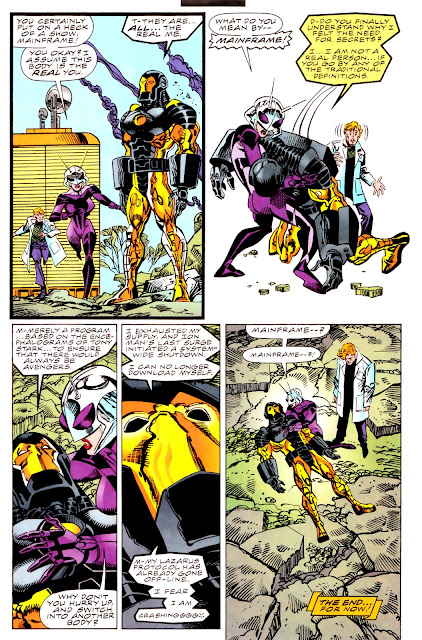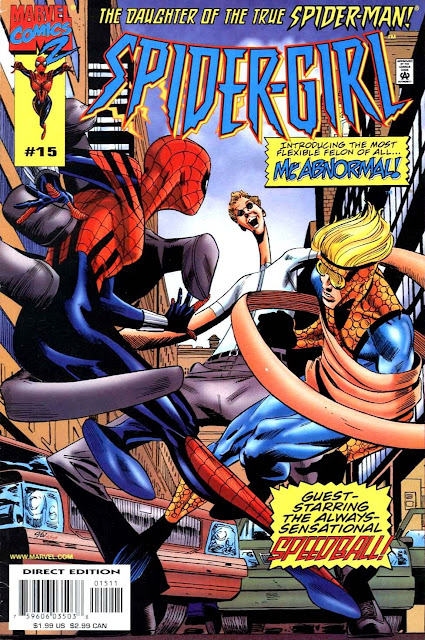I thought it might be fun to work out the approximate ages of the various members of the MC2’s Avengers. Keep in mind this isn’t definitive unless it’s spelt out on the page and is merely a rough estimate based on in-universe information or- where necessary- statements from the creative teams involved in the characters creation and development.
For the fourth entry in this occasional series of A-Next Ages, it’s time to figure out the age of the team’s by the book mysterious machine-man: Mainframe!
Unlike my prior three post in the series, we don’t have to look to far to figure out the age of this artificial Avenger. Let’s revisit Mainframe’s debut to start with: A-Next #1. It’s here we get the first hint about Mainframe’s identity. When Loki’s magical energy bolt is detected by monitors built into the Avengers Compound defences, they bring online a ‘long dormant program’. The program sends out an emergency call to assemble to over a dozen locations, but which is only received by two former Avengers; Jubilee and Jolt.
This may seem a little pointless to mention, but shortly
after when Jubilee asks who sent out the Avengers distress call, Mainframe’s
responds ‘That would be me’. So, in the very first issue we had a major
clue to Mainframe’s true identity right on the page.
After a few more clues, including Mainframe being seemingly killed when torn in half by Namor the Sub-Mariner and the Incredible Hulk in A-Next #3, we got answers in A-Next #7. Having exhausted all of their current supply of mechanical bodies during a battle with Ion Man, Mainframe reveals to Stinger (Cassie Lang) that they are in fact a program based on the encephalograms of Tony Stark to ensure there would always be Avengers. Left unable to download into a new body and suffering a system-wide shut down, Mainframe is fortunately saved the by the intervention of Cassie and her father, Scott Lang (formerly Ant-Man) in A-Next #8.
So, when did Tony Stark create Mainframe? We learn from Jarvis in A-Next #7 that the Original Avengers disbanded some 10 years prior to the new team’s formation, and that the fateful mission which saw so many of the team perish occurred a year and a half prior. This places their final mission at around 11 and a half years prior to the events of A-Next #1 as I’ve discussed previously here.
Iron Man (Tony Stark) and the Scarlet Witch (Wanda Maximoff) toiled away for months afterwards deep beneath the Avengers Mansion, eventually succeeding in closing the portal between worlds by sealing Wanda in a stasis pod which used her immense power to hold the aperture shut. Immediately after this event, Tony retires from super heroics, vowing to instead help the world using his other talents.
Around this time -though it's unclear whether it was before,
after or both before and after the team's final mission- Tony
Stark developed and completed work on Mainframe, the sophisticated
robotic armour imbued with Tony's own brain patterns, designed to ensure there
would always be someone to answer the call to assemble (A-Next #7, Spider-Girl
#95). From this we know that Stark completed work on Mainframe
around the time he left the Avengers, which was about 11 years prior
to A-Next #1.
As a program inhabiting an armoured robot suit, it’s difficult to assess Mainframe’s age by human standards, but we do see hints throughout the MC2 titles of the character’s development and personality. This includes his strained relationship with his creator or ‘father,’ Tony Stark. But as for how long Mainframe has been in existence in-universe? Mainframe is only at most 11 years old in A-Next #1 and that’s probably the first ever time the being had been out in the really world. By the conclusion of the MC2 publication history, another full year may have passed, making Mainframe at most 11-12 years old and ironically the youngest member of the Avengers.
Until I spend 11 years sitting on a computer in a dark basement, I remain
frogoat


















